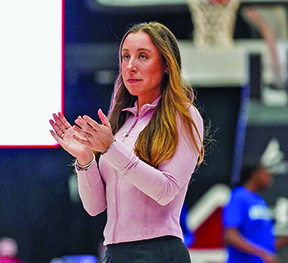CAPE MAY — In a large-scale expansion of the city’s cost-sharing program, the city is planning various sidewalk improvements, including replacing deteriorated concrete and resetting uneven brick and bluestone pavers.
Under the 50/50 program, the homeowner pays for half the repair cost and the city pays the other half.
Engineer Vince Orlando told City Council on Aug. 19 that design technician Patrick McNally started looking at the sidewalks from Ocean Avenue to the Washington Street Mall and all the way to Beach Avenue.
“Patrick went out to do a visual and quantitative analysis of what’s there and come up with a game plan [for] sidewalk and curb restoration,” Orlando said. “Patrick has done the study area; he lives in Cape May, so he’s very familiar with it.”
Orlando added that City Manager Paul Dietrich will be involved in the sharing component by contacting residents.
McNally said they went to each street and tried to find any obstacle along the sidewalks that would cause someone to trip.
“Even more to that point, accessibility,” McNally said. “A lot of sidewalks we looked at the shade trees, how old they are, if they’ve deteriorated or been repaired.”
Regarding Ocean Street and Columbia Avenue, McNally said they are not looking to replace the slate sidewalk entirely and may reuse some of the pieces.
“As far as concrete would go, it would be a full replacement,” he said. “When we started going out, it was more for a scope and it grew.”
Initially, McNally said they began looking at Ocean Avenue, Columbia Avenue and Virginia Avenue. Since then, they have expanded to sites away from those streets where there was an extreme limit to accessibility, including sites on Maryland and Ohio avenues, down to Beach Avenue.
Orlando said the nature of the project will allow the city to define a scope and potentially expand if there are other areas of interest.
Deputy Mayor Maureen McDade asked who would be notifying property owners.
Dietrich said once City Council authorized the project, the city would send out notices to property owners identifying the quantity that they have on their property to be replaced and the price, based on an engineer’s estimate.
“Then once the project would come out, before we would award it, we would contact the property owners and let them know” the bids were in, the cost and their share of the cost, Dietrich said. “It’s similar to what the Shade Tree Commission has been doing with the 50/50 program.”
Dietrich said they will work on providing payment accommodations.
“It would not be the intent to come out and say they owe us this next month,” Dietrich said. “But look at a basic program so they could afford it over a couple of years.”
Orlando added that the big thing with this project is to increase public safety.
“Homeowners may or may not be aware that they’re responsible for that sidewalk,” Orlando said. “I think this project, hopefully, will be seen by the community to be proactive to avoid any problem for you in the future.”
Dietrich said council budgeted $600,000 for the project but he did not think the work would cost that much.
“We needed to figure out a scope of what we could do,” he said. “The anticipation is that once this was done and we had a good feel for how it’s going to be contracted, then we’ll start looking at other areas within the city.”
Mullock said he wanted the public to hear more about the slate sidewalk discussion.
“Most people recognize the Historic Preservation Commission requires that you keep the slate, which we totally understand,” Mullock said. “However, the replacement that homeowners have done over the years is lacking in a lot of locations.”
He further explained that McNally was describing putting down a concrete base first, then laying the slate onto it. Orlando said that this practice would be more sustainable over time.
McNally said the goal is to reuse the slate that can be reused and replace what needs to be replaced.
“There will be a concrete base, maybe some sort of leveling sand and then on top, the slate,” McNally said. “The appearance would be the same, but in terms of durability over time, and especially people driving over it in driveways, it will extend the life greatly.”
Cape May Tennis Club
The city is also moving forward with its work on ADA compliance projects, including an upgrade at the city-owned Cape May Tennis Center.
The city previously received a Department of Community Affairs Small Cities Grant of $270,672 with a 10 percent match.
The project includes a handicap bathroom, handicap parking, a ramp to the pavilion and accessible pathways.
“One of the things we wanted to accomplish here was [tying] the Madison Avenue sidewalk through Kiwanis Park, into the tennis club,” Orlando said. “The idea is to create a continuous walkway through the park, down the Physick Estate and back out to Washington Street.”
McNally and Dietrich worked on a route along with Cape May MAC and the tennis center.
Dietrich said that because of the bathroom, the project might be done in two phases, with the sidewalk and access to the pro shop and gazebo as one project.
“Because it’s a building with a restroom, it might be better to bid that separately than from a concrete sidewalk project,” Dietrich said.
McNally said one of the biggest concerns around town is parking, and the changes that have come about were all related to that.
Mullock said as part of the project, he wanted to see a small sign on Washington Street directing people to the new pathway as a safer route.
“People have been going through Kiwanis Park, which is making the route shorter and safer,” McNally said. “If we can do something to promote that and utilize that this provides a great pathway as well, it’s really good for us to encourage more foot traffic.”
By RACHEL SHUBIN/Special to the Star and Wave


